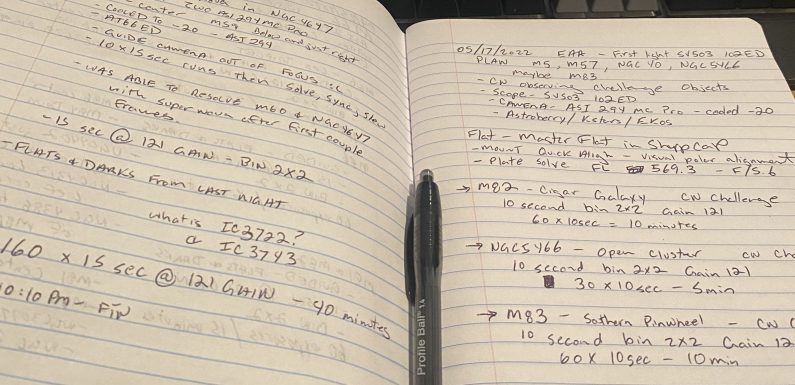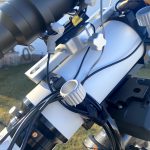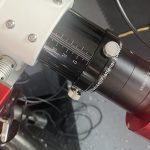
I keep a log book of all my observing sessions. Some of my logs are more detailed than others, but I always keep a log. There are a number of different astronomy log books out there, but my log books are just inexpensive composition notebooks where I hand write notes while observing. I reference these notes when writing my blog posts and for planning future observing sessions. This post covers what I typically try to note in my log book for each of my EAA and visual observing sessions.
Many of the planetarium software products available include the ability to log observations. I prefer handwritten logs during my sessions, it is just easier for me as opposed to typing something out.
Capturing, stacking, and saving images during an EAA session provides a visual record of observing a target, but since EAA is a form of real-time observing I find it helpful to also take notes. These notes are especially useful if there is something interesting I notice while observing an object during a live stack, if I had some kind of issue while observing a target (including if and how I over came the issue – some times you just have a bad night and things don’t work right), or if there is some process which worked especially well (a camera setting, a software setting, a workflow, etc).
When I start each observing session I typically note the following information:
- Start Date/Time and type of session (EAA, Visual, Testing, etc)
- Plan (if I have one)
- Equipment (scope, focal reducers, spacers, mount, camera, filters, eyepieces, etc) and software I am using for EAA sessions.
- Plate solving focal length
- Darks or Flats Captured
- Weather Conditions – Temperature, Wind, Clouds
- Polar Alignment – Method (Visual or Software assisted) and accuracy of polar alignment
- Moon visible and phase
For each object I observe during the session I try to note the following:
- Object name and type (galaxy, open cluster, nebula, double star, etc)
- Eyepiece or Camera Settings (Exposure length, number of exposures, gain, binning)
- How many exposures/how long before I could start to resolve the object or details? Especially on dimmer or more difficult objects.
- Guiding – Am I using the guide scope/camera while observing this object?
- Anything I find interesting about the object or anything else interesting in the FOV?
- Any issues encountered while observing the object?
At the end of the observing session I record the following:
- End Date/Time of Session
- Anything else interesting or any issues I had during the session.
Not only does keeping a log help me remember what I observed, it also provide me with notes of the how and why which help me improve future observing sessions. I can also look back on what I observed last week, last month, last year, to help me plan future sessions. There may be things I want to revisit, targets which I had difficulty with that I want to try again, or there may a method or process I want to try.
Practice keeping a log of your observing. Review your logs from time to time. You will probably learn a lot and it will likely help improve your future observing sessions.
Looks like we might have a clear sky this Saturday night, so more EAA and more logs!









